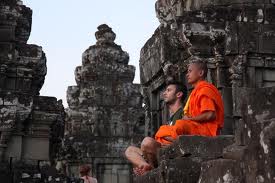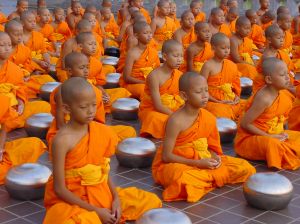I woke from sleep in the early morning hours recently, and my first conscious thought consisted of the word “provisionality”. It was as prominent as if a banner with the word had been hoisted across the foot of my bed. And I knew at once why it was there, and what it meant.
A few hours earlier I’d been struggling unsuccessfully to draft an article on meditation for this blog. This unannounced and unexpected banner-headline in the quiet of my bedroom, in the dark, turned a searchlight on my struggle, and resolved it.
While I was sitting in front of my monitor, I couldn’t put into words the conflict I was experiencing about Robert’s intelligent disquisition on the hindrances to meditation, which seemed to reflect the kind of stuff I’ve read before in Buddhist tracts and articles about how arduous and difficult meditation is, but worthwhile for the ultimate reward of solitary ecstasy . They all have that hallmark of the experience of robed sitting by people, almost exclusively men, who – by sitting in meditation for many years and by assiduous effort, overcoming formidable obstacles and hindrances – have reached the pinnacle of spiritual attainment, personal enlightenment.
How could I question that? Yet I still do, insistently.
Let me return to my sudden waking up, and set aside the conflict for a moment, though I think they’re linked somehow. Maybe that’s my inner philosopher in me speaking, with new-found confidence, and in a softer, more open and provisional style.
What follows is a rather crude and simplistic comparison of two approaches to meditation, devised by me, and based on my own experience of, observation of, and talking with women, especially nurses, but also Buddhist women, and of women in Africa, where lifestyle is still quite other than here in the developed Northern hemisphere (still curiously referred to as ‘the West’).
‘Male ‘model of meditation and principles of practice
Emphasises physical stillness in a prescribed erect sitting posture, eyes closed to shut out worldly distractions.
More or less totally (and deliberately) divorced from all forms of common worldly activity or engagement with other people e.g. social or family relationships, childcare, sexuality, work (including housework and gardening or growing crops), play, leisure, celebration, contingent events etc.
Performed in complete silence, often regards sound as a distraction or as contamination.
Solitary practice encouraged, group meditation takes care to exclude the possibility of any physical contact by meditators.
Oriented to personal achievement of bliss, ascending hierarchy of attainment (simile: climbing a lofty mountain, leaving the world and its cares far below).
Highly structured, elaborately detailed, concept-laden and often ‘scripted’ technique to be followed, rigour recommended.
Narrow focus of attention, discipline and effort prized.
Body regarded as vehicle for mind, used instrumentally, often seen as source of undesirable distraction from mind (Body-Mind dualism).
Teaching (on technique and to provide ideological buttressing) originated, articulated, controlled and directed (almost exclusively) by men.
Women’s voices and unique experience marginalised.
‘Female’ model of meditation and principles of practice
Allows and promotes activity and movement, spontaneous and purposive, open to the world and embraces it, eyes open.
Integrates short, naturally occuring periods of stillness, silence and relaxed, comfortable repose (no imposed postural requirements) with activities of daily living, and seamlessly in relationship with other people (specially attentive to children, the elderly, or animals), on an emergent basis as life unfolds.
Encourages and welcomes togetherness, especially the company of other women.
Characterised by shared conversation, or singing/crooning, and comfortable shared silence, especially when carrying out shared activities (household tasks, cultivating gardens, fetching water or firewood, weaving or sewing, pounding or sieving grains, community cooking,
reciprocal grooming like hair plaiting, manicure etc).
Oriented to cooperative, cohesive and collective purposes.
Uncontrivedly self-effacing and ‘unselfish’.
Body-mind understood in ‘wholistic’ terms, expressed as an intuitive apprehending of feelings, and understanding sensations as metaphors of influence and meaning, a naturalistic and concept-free ‘integration of desires’.
Wide focus of attention, open to the whole visual (and aural and osmic) field, while (like a bird) able to pick up particular detail. (‘without stirring from the unity of self-refreshing pristine awareness, the details of experience are clearly differentiated without being contrived’ [Longchenpa])*
Uncontrived: elaborate conceptual expressions of technique and ideological underpinnings for meditation experienced as redundant, at variance with women’s experience, and ironically referred to as “typically male” or in other earthy, bawdy terms…..!)
Teachings shared informally, in light jests or personal anecdotes, by story-telling, in songs or poems, in pictures, or by clothing, body adornments, experiment and innovation in make-up and hair-styling,
through the positioning and re-arrangement of household articles, artefacts, flowers or elemental things (feng shui).
Women will share generously and with no expectation of reward or desire for acclaim or special ‘recognition’.
Men only have to notice that they are there, and that their contribution to meditation practice, although divergent, is of equal value to mens’.
* Quoted from Longchenpa, You Are the Eyes of the World, translated by Lipman K, Peterson M (2000), Snow Lion Publications, New York













